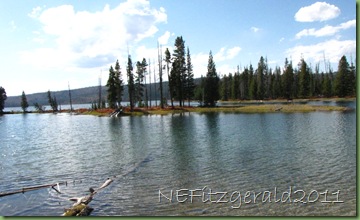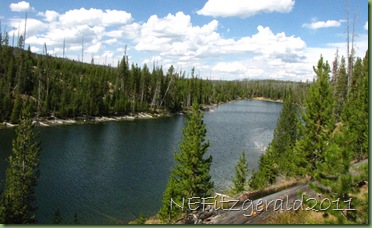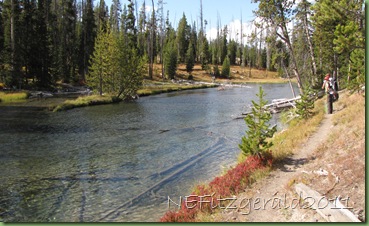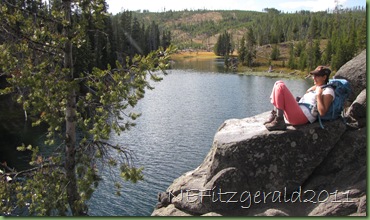Oh, yeah. Talk about tasty!
According to US Fish & Wildlife, Yellowstone’s Shoshone Lake is the largest backcountry lake in the lower 48 states that cannot be reached by a road. Early explorers to the area thought it flowed into the Madison River and so into the Atlantic Ocean. But in 1865 explorer and civil engineer Walter deLacy published his Map of the Territory of Montana with portions of the Adjoining Territories which showed “…hot springs at the head of an unnamed lake draining southward into “Jackson’s Lake” on the Snake River in present–day Grand Teton National Park. This unnamed lake was identified in 1867 as deLacy’s Lake and remained so until, a short time later, its name was changed to Shoshone Lake by a member of Hayden’s Geological Survey of the Territories.
 |
| Shoshone Lake |
There are several routes into the lake – on this first of October day we choose to start at the Lewis Channel trailhead. This scenic seven – mile trail skirts the northern edge of Lewis Lake and then follows a channel connecting Lewis and Shoshone lakes. It is a fairly easy cruise, with minimal contouring up and down low hills along the water’s edge and nearly non-stop views.
 |
| Lewis Lake with Teton Range in hazy distance |
 |
| Mouth of Lewis Channel |
 |
| Lewis Channel |
 |
| Lewis Channel |
 |
| Meandering trail along Lewis Channel |
We pause to watch kayakers and canoeists drift into view from upriver and then fade away downstream; we catch a fleeting glimpse (“What was that?”) of a short–eared owl as it silently streaks past our heads, seemingly low enough to snatch a hat or two in its talons. As the others relax, our angler feels the urge to drop his line in the water at a rocky outcrop. Further along the trail we graze on a few sweet huckleberries lingering at the end of their summer abundance. We are definitely not breaking any land–speed records on this leisurely afternoon trek.
 |
| Canoeists paddle Lewis Channel |
 |
| Relaxing on the rocks along Lewis Channel |
 |
| Waiting for some action on Lewis Channel |
 |
| Grazing an early October huckleberry patch |
Eventually we reach the patrol cabin, an A–frame affair situated snugly at the edge of Shoshone Lake. We toast to our good fortune! We hope to see moose, we hope to see bears, we hope to see any wildlife besides a chattering ground squirrel unhappy with our intrusion into its domain.
 |
| Shoshone Lake patrol cabin |
 |
| View from the cabin porch |
 |
| Cheers! |
What we do soon see is a fat brown trout on a line. Oh, yeah – dinner will be served!
 |
| Dinner |
After our angler cleans his catch and sets it marinating in his secret blend of herbs, spices, and maple syrup, we all partake of that time–honored tradition of any lake visitor. We sit and watch the setting sun cast its golden glow behind low hills and gathering clouds. Then we go inside to enjoy our feast, have a nip while we play rummy by candlelight, and then fall cozily asleep, our mattresses arranged at tidy angles on the patrol cabin floor.
 |
| Dinner awaits |
 |
| Sunset over Shoshone Lake |
 |
| Later that same evening… |
The next morning during a breakfast of tea and silver–dollar pancakes with huckleberry syrup we all comment on how this hike to Shoshone Lake is a perfect conclusion to our Yellowstone summer. We wash the dishes, re–hang mattresses on beams, sweep the floor, and lay a fire in the stove, aiming to leave the cabin in better condition than we found it. Then, in the drizzly gray of a misty morning we bid farewell to our final patrol cabin experience of the season and make our way four damp miles down the Dogshead trail back to our cars. We never do see a moose or a bear, but what we do see over the two days is exceptional.
 |
| Leaving it cleaner than we found it |
 |
| Red Mountains in the mist from Dogshead Trail |


























